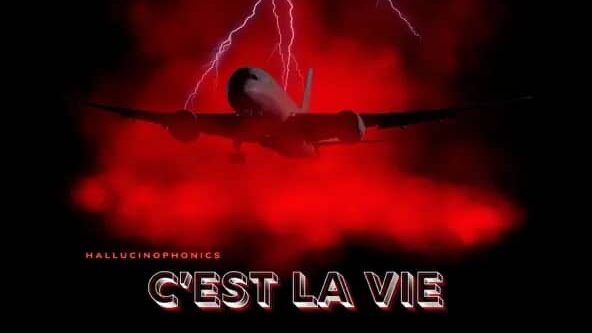Hallucinophonics’ “C’est La Vie” opens as a careful invitation to reflection, presenting itself as a compact yet expansive meditation on acceptance and quiet transcendence. From the first wash of ambient synthesis the track stakes out a broad sonic field that feels both intimate and cinematic, a place where sparse melodic fragments can breathe and accumulate emotional weight. The song moves with deliberation rather than haste, choosing to reveal its motives slowly so that each new instrumental color registers as a meaningful shift. That compositional patience gives the music room to balance melancholy and warmth, so that moments of tension resolve into a kind of fragile consolation rather than sudden catharsis. As a statement it is direct and assured, treating atmosphere as substance and thematic coherence as a structural priority.
Structurally the piece unfolds like a miniature suite, a sequence of linked tableaux that trade in texture as much as in formal contrast. It begins with open, reverberant pads that create an ambient horizon, then introduces percussive elements and a low register anchor that gradually define forward motion. Melodic ideas are presented sparingly and returned to in altered form, which gives the song a sense of development rather than repetition. Harmonic movement rests on modal coloration and suspended sonorities that allow for shifting emotional inflection without relying on conventional verse chorus signposts. The arrangement is carefully weighted so that instrumental entries function as narrative beats, and the transitions between sections are shaped by automation and subtle countermelodies rather than by abrupt breaks. That approach produces a continuous arc that feels intentional and complete within its running time.
The instrumentation is layered with an acute awareness of timbre and spatial relationships. Lush synth pads form the song’s initial bed, combining warm analog style voices with brighter digital textures to create both gravity and shimmer. Guitar parts are patient and textural, using long sustain, tasteful slides and time based effects to produce a singing presence rather than sharp aggression. The bass performs dual roles as harmonic foundation and melodic commentator, moving in supportive lines that enrich the low end without crowding the midrange. Percussion blends acoustic and processed elements in a way that reads as organic and ritualistic; hand percussion and tom patterns give the groove a human pulse while drum kit components add momentum at key junctures. Small sound design details such as filtered risers, subtle reverse tails and slow modulation on pad layers enhance the scene without ever sounding ornamental.
Vocally the performance is intimate, present in the mix and yet embedded within the atmospheric world of the track. The lead vocal is delivered with a breathy clarity that carries emotional specificity, and restrained harmonies expand the emotional palette where the arrangement requires weight. Lyrical content favors evocative imagery over literal narrative, deploying metaphors of collapse, beauty and surrender that invite personal projection. Phrasing is controlled and expressive, and the production places the voice so that emotional nuance is audible in the breath, the small pitch inflections and the quiet consonant details. At moments when the lyrics ask for emphasis the arrangement responds by thickening harmonic density and letting guitars and pads support the vocal line, while in reflective passages the instrumentation retreats to reveal the song’s inner voice.
Production and mixing are crafted to foreground immersion and clarity simultaneously. The mix uses extended reverberation and tempo related delays to build a three dimensional field, while careful equalization keeps the midrange clean so guitars and vocals read distinctly against the pad wash. Spatialization is used as a compositional tool, with elements placed across the stereo field and slightly varied in depth to suggest movement and distance. Automation sculpts dynamic growth so that layers bloom naturally and then recede, creating the sensation of breathing within the arrangement. The low end is controlled and rounded, giving the track presence on small speakers while maintaining body on full range systems. Mastering preserves the dynamic architecture, allowing the piece to retain nuance on streaming platforms without losing the immersive quality that defines its character.
Emotionally “C’est La Vie” succeeds because it balances conceptual weight with tactile musical detail. Its strengths lie in its cohesive arrangement, the clarity of its production choices and the directness of its vocal delivery, all of which serve the central theme of peaceful acceptance. The track rewards focused listening, revealing additional instrumental gestures and production refinements on repeated plays, which makes it durable and engaging beyond a first impression. If one critique exists it is that the emphasis on atmosphere over immediate melodic hooks can delay full emotional recognition for listeners who favor more declarative songwriting, yet that restraint is also the song’s principal virtue because it lets feeling accumulate rather than forcing it. In the context of contemporary progressive and space oriented music this recording is a confident, mature work that signals both artistic vision and technical command, and it leaves the listener wanting further explorations from Hallucinophonics in the same contemplative register.
For more information about Hallucinophonics, click on the icons below.



